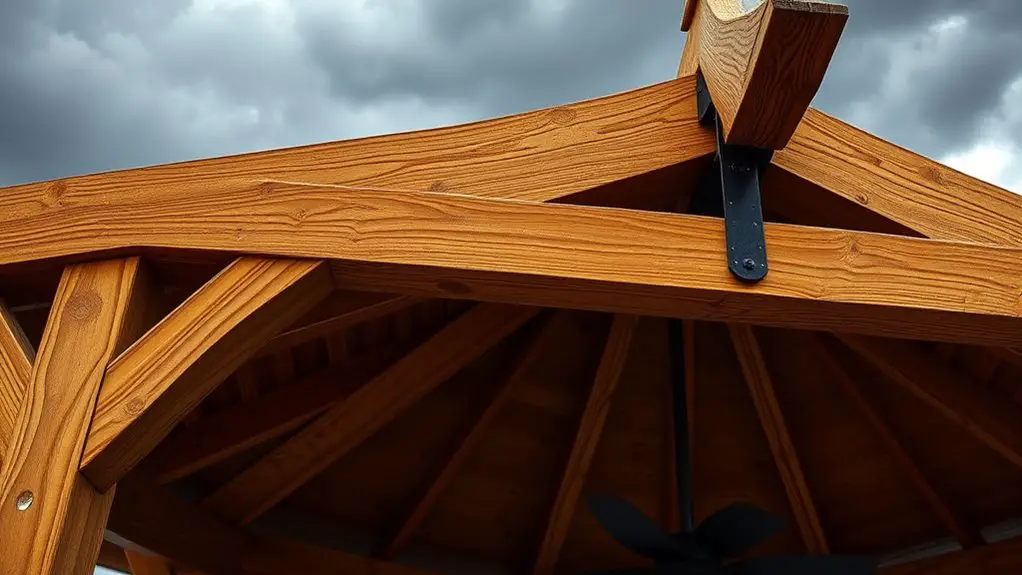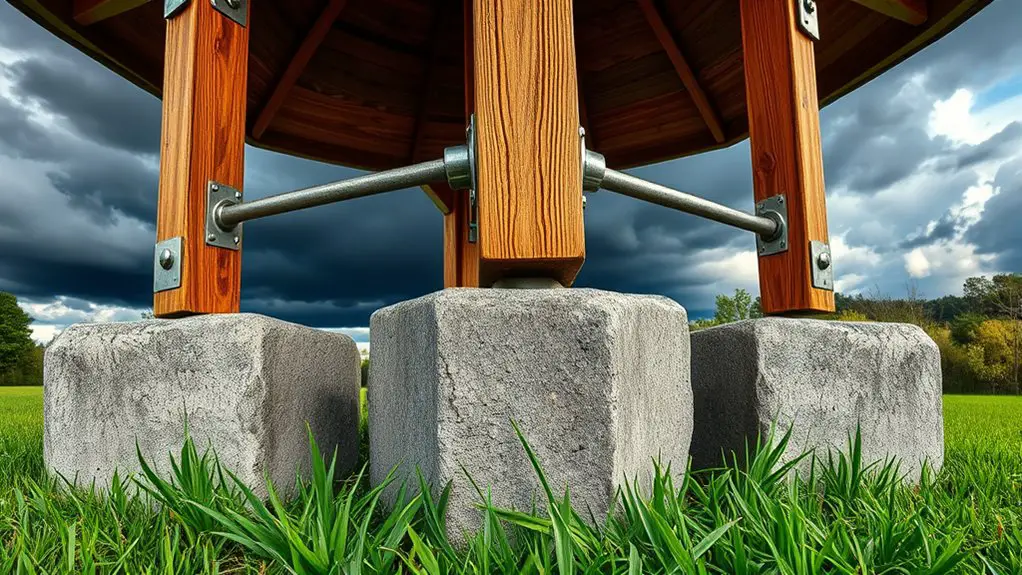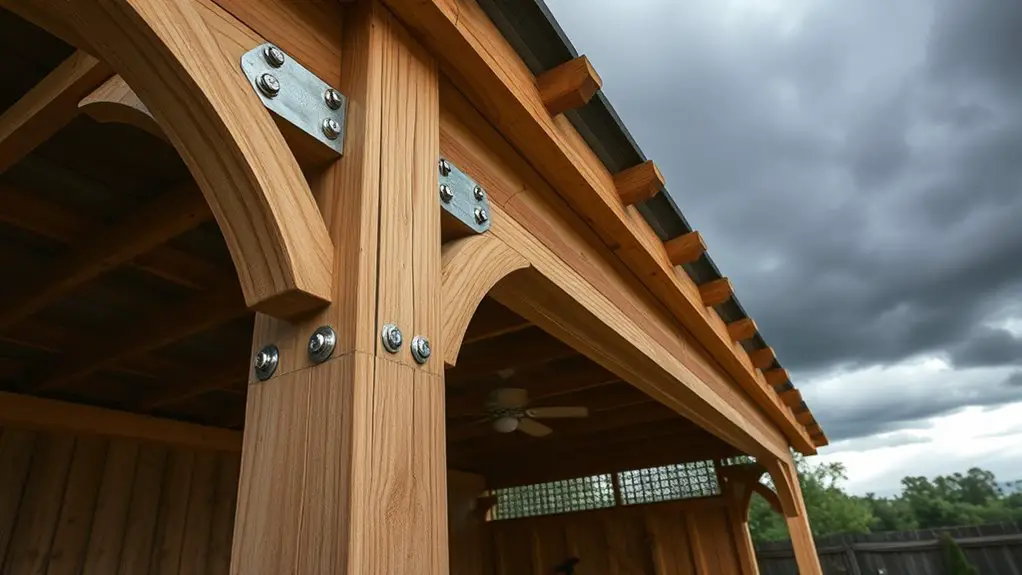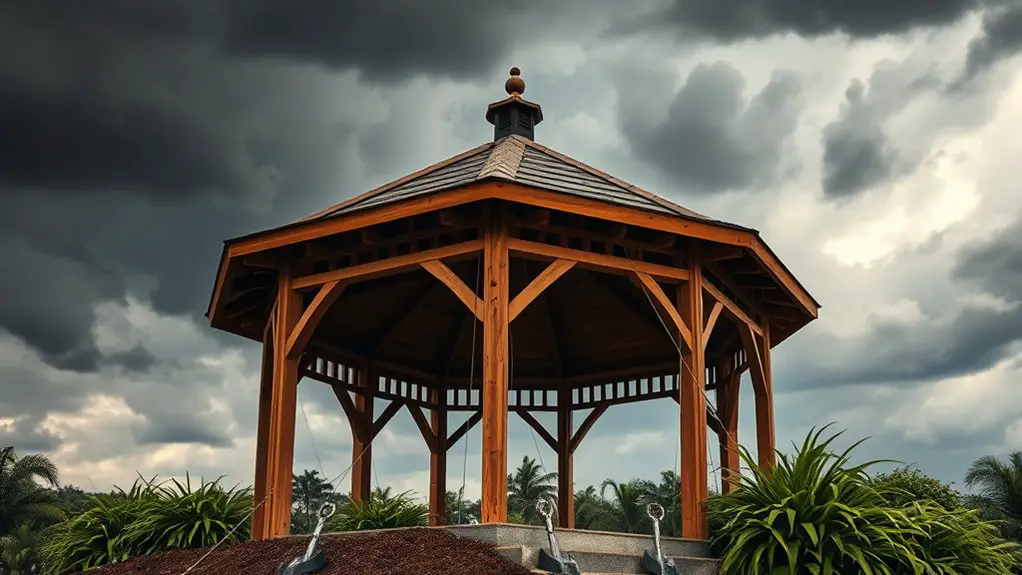To reinforce your gazebo for extreme weather, start by evaluating its structure for wear and damage. Choose durable materials like galvanized steel and pressure-treated wood for added strength. Secure the foundation with concrete footings and proper anchoring to withstand uplift forces. Strengthen the roof with durable materials and additional bracing to handle snow loads. Finally, install wind braces for extra stability and conduct regular inspections to verify everything remains secure. You’ll uncover more enhancement techniques shortly.
Assessing Your Gazebo’s Current Structure

Before reinforcing your gazebo for extreme weather, it’s crucial to assess its current structure. Start by examining the gazebo design, focusing on joints, support beams, and overall stability. Look for any signs of wear or damage that could compromise its weather resistance. Check for rust on metal components or rot on wooden elements; these issues can weaken your gazebo considerably.
Next, evaluate the foundation and anchoring system. Verify it’s secure and appropriate for your gazebo size and local weather patterns. Pay attention to any sway or movement when subjected to wind; this indicates inadequate support.
Finally, consider the roof’s integrity. Is it designed to withstand heavy rain or snow? Assess any drainage systems in place. By methodically evaluating these components, you’ll gain a clear understanding of your gazebo’s current capabilities and limitations, allowing you to plan effective reinforcement strategies. Additionally, ensure you are aware of seasonal care tips to maintain the gazebo’s resilience throughout the year.
Choosing the Right Materials for Reinforcement
When selecting materials for reinforcing your gazebo, it’s important to reflect on both durability and compatibility with your existing structure. You’ll want to choose materials that provide ideal weather resistance while guaranteeing long-lasting performance. Here are some options to take into account:
- Galvanized Steel: Offers excellent strength and corrosion resistance.
- Pressure-Treated Wood: Resists decay and insects, enhancing material durability.
- Fiberglass Reinforced Plastic: Lightweight and resistant to extreme weather conditions.
- Concrete Footings: Provides a solid base, essential for stability during severe weather.
Each option has unique properties, so it’s critical to evaluate how they integrate with your gazebo’s design. Prioritize materials that can withstand harsh elements while maintaining structural integrity. This approach not only safeguards your investment but also guarantees you can enjoy your outdoor space regardless of the weather. Additionally, consider using steel frames for their superior durability and strength, which can significantly enhance the resilience of your gazebo against extreme weather conditions.
Securing the Foundation

To guarantee your gazebo withstands extreme weather, securing its foundation is essential. Start by evaluating the foundation types suitable for your specific climate and terrain. Options like concrete slabs, piers, or helical anchors can provide varying levels of stability. Each type has its advantages, but selecting the right one hinges on soil stability.
Conduct a soil test to determine load-bearing capacity and drainage characteristics. If the soil is unstable, you may need to reinforce it with gravel or compacted fill before installation. Ascertain that the foundation is anchored deeply enough to resist uplift forces from wind or flooding. Incorporating tie-down straps or brackets can further enhance stability, especially in high-wind areas. Remember, a well-secured foundation not only prolongs the life of your gazebo but also offers peace of mind during extreme weather events, allowing you to enjoy your outdoor space freely. Additionally, ensure you use heavy-duty anchors for maximum stability against strong winds.
Strengthening the Roof
Once the foundation is secured, the next step is reinforcing the roof to withstand extreme weather conditions. The roof is your gazebo’s first line of defense against harsh elements, so choosing the right roof materials is essential. Here are important measures to enhance its weather resistance:
- Opt for durable roofing materials: Select metal, asphalt shingles, or composite materials for longevity.
- Ensure proper slope: A steep roof slope allows water and snow to slide off, reducing weight and potential damage.
- Install additional bracing: Use cross-bracing or purlins to strengthen the roof structure and prevent sagging during storms.
- Inspect and maintain regularly: Regular checks for wear or damage can help you address issues before they escalate. Additionally, consider using durable materials that can withstand the test of time and provide optimal protection against the elements.
Reinforcing the Walls and Supports

To guarantee your gazebo withstands extreme weather, it’s essential to strengthen its walls and supports. You’ll need to choose quality materials that enhance structural integrity and resist deterioration. Additionally, securing the framework with reliable anchors will provide the stability necessary to endure high winds and heavy precipitation. Incorporating proper anchoring techniques can significantly improve your gazebo’s ability to resist strong winds and ensure its longevity.
Strengthen Structural Integrity
As extreme weather events become more common, reinforcing the structural integrity of your gazebo is essential for guaranteeing its longevity and safety. You need to focus on key structural enhancements that boost weather resilience. Here are some effective strategies:
- Install diagonal bracing to distribute loads and minimize swaying.
- Secure the joints and connections with heavy-duty fasteners for added stability.
- Reinforce the walls with additional panels or sheathing for strength.
- Evaluate the foundation to ascertain it can withstand shifting or erosion.
Use Quality Materials
The foundation of a resilient gazebo lies in the quality of materials used for reinforcing its walls and supports. When selecting materials, you should prioritize quality wood and durable metal. Quality wood, such as cedar or redwood, offers natural resistance to decay and withstands various weather conditions effectively. Verify the wood is treated to enhance its longevity and structural integrity. For metal supports, opt for galvanized steel or aluminum, which resist rust and corrosion, providing a robust framework. These materials not only enhance the gazebo’s aesthetic appeal but also contribute considerably to its overall stability. Investing in high-quality components will result in a stronger, more reliable structure, allowing you to enjoy your gazebo regardless of extreme weather challenges.
Secure With Anchors
Quality materials alone won’t guarantee that your gazebo withstands extreme weather; securing it with appropriate anchors plays an essential role in reinforcing the walls and supports. Proper anchor placement is vital for maximum stability, ensuring your gazebo remains intact during high winds and heavy storms.
Consider the following anchor types:
- Ground augers: Ideal for soft soil, providing deep stabilization.
- Concrete anchors: Perfect for permanent installations in solid surfaces.
- Expansion bolts: Best suited for wooden structures, ensuring a tight grip.
- Rebar stakes: Effective in securing lightweight gazebos against strong gusts.
Installing Wind Braces
To enhance your gazebo’s stability against strong winds, selecting the right materials for wind braces is essential. You’ll need to take into account both the strength and durability of the materials to guarantee peak performance. Additionally, understanding proper installation techniques will maximize the braces’ effectiveness in reinforcing your structure. Properly securing your gazebo with anchoring techniques is crucial for preventing potential damage during extreme weather conditions.
Choosing Appropriate Materials
Selecting the right materials for wind braces is essential when reinforcing a gazebo against extreme weather. You’ll want to guarantee the materials not only provide strength but also offer weather-resistant options and material durability. Here are some key considerations:
- Steel: Known for its high tensile strength and resistance to rust when treated.
- Aluminum: Lightweight yet durable, ideal for easy installation and protection against corrosion.
- Composite materials: Offer great strength while resisting moisture and decay.
- PVC: A cost-effective choice that’s lightweight and resistant to environmental wear.
Installation Techniques Explained
When installing wind braces for your gazebo, it’s essential to follow precise techniques to secure maximum stability during extreme weather events. Start by selecting the right angle for your braces, typically between 30 to 45 degrees, to effectively distribute wind loads. Securely attach the braces to both the vertical posts and the roof structure using bolts or heavy-duty screws.
Here’s a quick reference table for installation techniques:
| Technique | Description |
|---|---|
| Angle Selection | 30-45 degrees for stability |
| Attachment Method | Bolts or heavy-duty screws |
| Material Quality | Use galvanized steel or aluminum |
| Test Stability | Perform a shake test post-installation |
Implementing these techniques guarantees enhanced gazebo stability, allowing you to enjoy your outdoor space with confidence.
Preparing for Snow Accumulation
As winter approaches, ensuring your gazebo can withstand heavy snow accumulation is essential for its longevity and structural integrity. Proper winter preparation involves evaluating the likely snow load your gazebo will face and reinforcing it accordingly. Here are key strategies to take into account:
- Evaluate the design: Determine whether your gazebo’s design can handle significant snow loads.
- Strengthen the roof: Reinforce the roof structure with additional supports to prevent sagging or collapse.
- Clear snow regularly: Make it a habit to remove snow buildup after each storm to minimize weight stress.
- Use weather-resistant materials: Employ durable materials that can resist snow-induced wear and tear, as hardtop gazebos are particularly well-suited for winter use.
Regular Maintenance and Inspections
While you might think that your gazebo is sturdy enough to withstand the elements, regular maintenance and inspections are crucial to guarantee its ongoing durability and functionality. Conducting regular checks is essential to identify any wear or damage that may compromise its integrity. Look for signs of rot, rust, or loose fittings, especially after extreme weather events.
Seasonal upkeep is equally important. Before winter, verify the roof is clear of debris and assess for any weak points. In spring, inspect the structure for damage caused by snow or ice. Apply protective coatings to wood and metal surfaces to prevent deterioration. Additionally, conduct regular inspections to check for loose seams and tears that could lead to more significant issues.
Don’t overlook the foundation; it should be stable and free from erosion. By committing to these routine inspections and maintenance tasks, you’ll not only preserve your gazebo’s beauty but also enhance its resilience against harsh weather, guaranteeing you can enjoy your outdoor space for years to come.
Frequently Asked Questions
How Often Should I Inspect My Gazebo for Potential Damage?
You should inspect your gazebo at least twice a year, focusing on potential damage. Regular gazebo maintenance guarantees storm preparedness, helping you identify weaknesses and prolonging its lifespan against harsh weather conditions. Don’t overlook this critical task.
Can I Reinforce a Gazebo Without Professional Help?
Certainly, you can enhance your gazebo’s stability without professional assistance. By employing DIY reinforcement techniques and considering material selection tips, you’ll empower yourself to create a more resilient structure that endures nature’s whims gracefully.
What Are the Signs of a Structurally Weak Gazebo?
You’ll notice signs of structural weakness in your gazebo if there’s noticeable sagging, cracked joints, or warped materials. These issues compromise its structural integrity and weather resistance, signaling a need for immediate attention and reinforcement.
How Do I Choose a Location for My Gazebo?
When choosing a location for your gazebo, consider ideal ground stability and adequate sunlight exposure. Positioning it in a well-drained area with best light guarantees longevity and enhances your enjoyment of the space.
Are There Any Local Regulations for Gazebo Reinforcement?
You’ll need to check local zoning laws, review building codes, and guarantee compliance. Ignoring these regulations can lead to fines, delays, and safety hazards. Stay informed, stay compliant, and enjoy your gazebo without worry.

